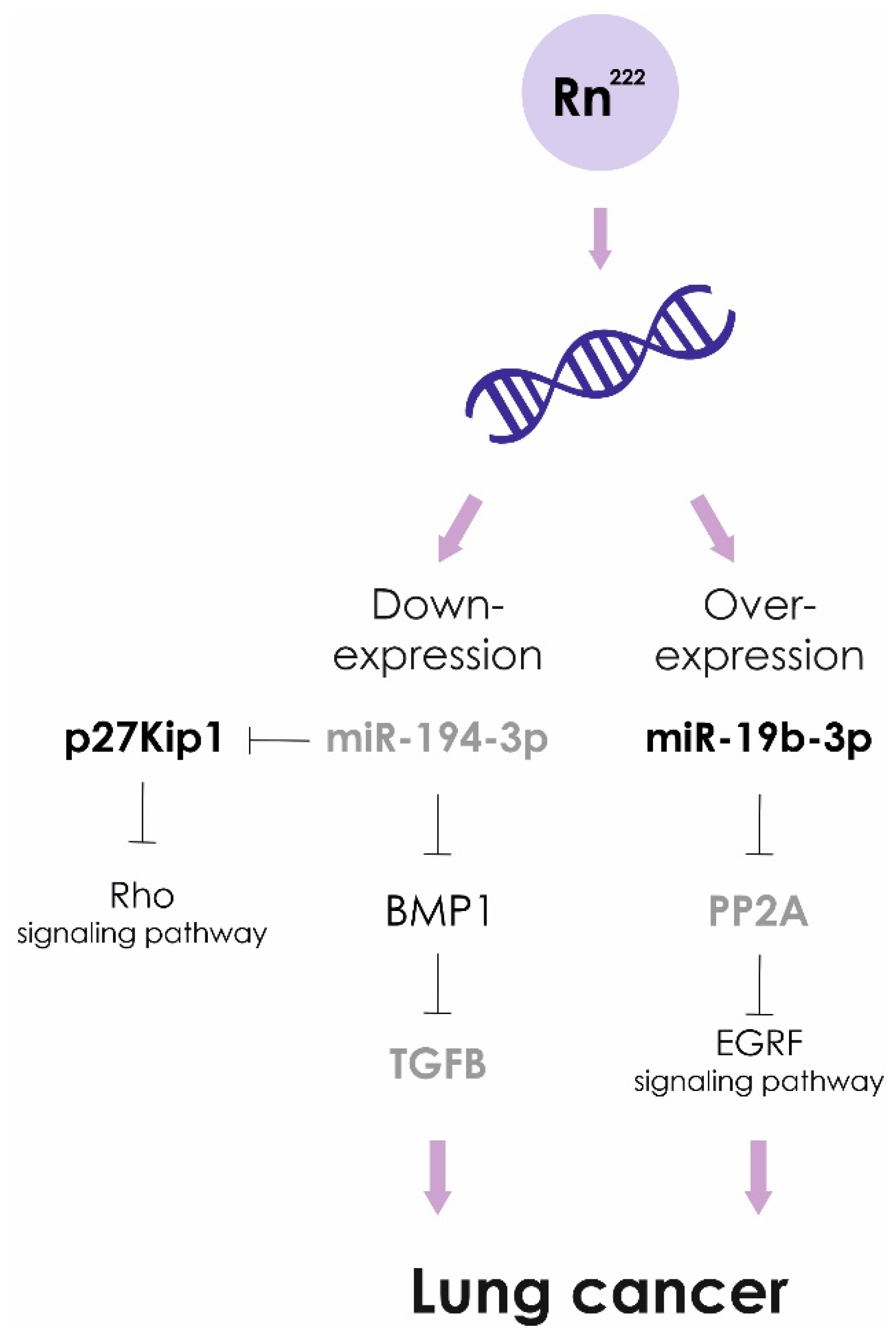Radon Biomonitoring and microRNA in Lung Cancer
Abstract
1. Introduction
2. Decay of Uranium: Radon as a Radiation Factor of the Environment
3. Toxic Effects of Exposure to Radon in Human
4. Radon Exposure and Lung Cancer: Epidemiology and Biomonitoring.
5. Radon Exposure and Lung Cancer: Pathogenic Mechanisms (Genotoxicity, Inflammation, and Oxidative Stress)
6. Epigenetic Factors in the Development of Cancer
7. Epigenetic Factors in the Development of Radon-Induced Lung Cancer
8. Conclusions
Funding
Conflicts of Interest
References
- Barta, J.A.; Powell, C.A.; Wisnivesky, J.P. Global Epidemiology of Lung Cancer. Ann. Glob. Health 2019, 85, 1–16. [Google Scholar] [CrossRef] [PubMed]
- Bray, F.; Ferlay, J.; Soerjomataram, I.; Siegel, R.L.; Torre, L.A.; Jemal, A. Global cancer statistics 2018:GLOBOSCAN estimates of incidence and mortality worldwide for 36 cancers in 185 countries. CA Cancer J. Clin. 2018, 68, 394–424. [Google Scholar] [CrossRef] [PubMed]
- Aggarwal, A.; Lewison, G.; Idir, S.; Peters, M.; Aldige, C.; Boerckel, W.; Boyle, P.; Trimble, E.L.; Roe, P.; Sethi, T.; et al. The State of Lung Cancer Research: A Global Analysis. J. Thorac. Oncol. 2016. [Google Scholar] [CrossRef] [PubMed]
- Jemal, A.; Bray, F.; Center, M.M. Global Cancer Statistics. CA Cancer J. Clin. 2017, 61, 69–90. [Google Scholar] [CrossRef]
- WHO 2009. WHO Handbook on Indoor Radon: A Public Health Perspective; World Health Organization: Geneva, Switzerland, 2009. [Google Scholar]
- Hubaux, R.; Becker-Santos, D.D.; Enfield, K.S.S.; Lam, S.; Lam, W.L.; Martinez, V. Arsenic, asbestos and radon: Emerging players in lung tumorigenesis. Environ. Health 2012, 11, 89. [Google Scholar] [CrossRef]
- Malhotra, J.; Malvezzi, M.; Negri, E.; La Vecchia, C.; Boffetta, P. Risk factors for lung cancer worldwide. Eur. Respir. J. 2016, 48, 889–902. [Google Scholar] [CrossRef]
- Nair, N.; Kumar, S.; Gongora, E.; Gupta, S. Circulating miRNA as novel markers for diastolic dysfunction. Mol. Cell. Biochem. 2013, 376, 33–40. [Google Scholar] [CrossRef]
- Hashemi, Z.S.; Khalili, S.; Forouzandeh, M.M.; Sadroddiny, E. Lung cancer and miRNAs: A possible remedy for anti-metyatsatic, therapeutic and diagnostic applications. Expert Rev. Respir. Med. 2017, 11, 147–157. [Google Scholar] [CrossRef]
- Wu, J.; Sun, B.; Zhang, S.; Zhang, J.; Tong, J.; Nie, J.; Li, J. Effects of radon on miR-34a-induced apoptosis in human bronchial epithelial BEAS-2B cells. J. Toxicol. Environ. Health 2019, 82, 913–919. [Google Scholar] [CrossRef]
- Wang, Y.; Wang, L.; Chen, C.; Chu, X. New insights into the regulatory role of microRNA in tumor angiogenesis and clinical implications. Mol. Cancer 2018, 17, 22. [Google Scholar] [CrossRef]
- Peng, Y.; Croce, C.M. The role of MicroRNAs in human cancer. Signal Transduct. Target. Ther. 2016, 1, 1. [Google Scholar] [CrossRef] [PubMed]
- Chauldhry, M.A. Radiation-induced microRNA: Discovery, Functional analysis, and cancer radioteraphy. J. Cell. Biochem. 2014, 115, 436–449. [Google Scholar] [CrossRef]
- Izzotti, A.; Calin, G.A.; Steele, V.E.; Croce, C.M.; De Flora, S. Relationships of microRNA expression in mouse lung with age and exposure to cigarette smoke and light. FASEB J. 2009, 23, 3243–3250. [Google Scholar] [CrossRef] [PubMed]
- Izzotti, A.; Pulliero, A. The effects of environmental chemical carcinogens on the microRNA machinery. Int. J. Hyg. Environ. Health 2014, 217, 601–627. [Google Scholar] [CrossRef] [PubMed]
- Cui, F.M.; Li, J.X.; Chen, Q.; Du, H.B.; Zhang, S.Y.; Nie, J.H. Radon-Induced Alterations in Micro-RNA Expression Profiles in Transformed BEAS2B Cells. J. Toxicol. Environ. Health Part A 2013, 76, 107–119. [Google Scholar] [CrossRef]
- Izzotti, A.; Carozzo, S.; Pulliero, A.; Zhabayeva, D.; Ravett, J.L.; Bersimbaev, R. Extracellular MicroRNA in liquid biopsy: Applicability in cancer diagnosis and prevention. Am. J. Cancer Res. 2016, 6, 1461–1493. [Google Scholar]
- Adrovich, F. Radon Phenomenon. In Radon; Adrovich, F., Ed.; InTech.: Croatia, Balkans, 2017; pp. 1–6. [Google Scholar]
- Vogiannis, E.G.; Nikolopoulos, D. Radon sources and associated risk in terms of exposure and dose. Environ. Health 2015, 2, 1–10. [Google Scholar] [CrossRef]
- Kang, J.K.; Seo, S.; Jin, Y.W. Health Effects of Radon Exposure. Yonsei Med. J. 2019, 60, 597. [Google Scholar] [CrossRef]
- Walsh, L.; Grosche, B.; Schnelzer, M.; Tschense, A.; Sogl, M.; Kreuzer, M. A review of the results from the German wismut uranium miners cohort. Radiat. Prot. Dosim. 2015, 164, 147–153. [Google Scholar] [CrossRef]
- Bersimbaev, R.I.; Bulgakova, O.V. The health effects of radon and uranium on the population of Kazakhstan. Genes Environ. 2015, 1, 37. [Google Scholar] [CrossRef]
- OECD-NEA & IAEA. Uranium 2018: Resources, Production and Demand (‘Red Book’); The Nuclear Fuel Report 2015, 2017 & 2019; World Nuclear Association: London, UK, 2018. [Google Scholar]
- National Research Council. BEIR 4, 198. Health Risks of Radon and Other Internally Deposited Alpha-Emitters: BEIR IV; National Academies Press: Washington, DC, USA, 1988; Volume 4. [Google Scholar]
- Tirmarche, M.; Harrison, J.D.; Laurier, D.; Paquet, F.; Blanchardon, E.; Marsh, J.W. ICRP Publication 115. Lung cancer risk from radon and progeny and statement on radon. Ann. ICRP 2010, 40, 1–64. [Google Scholar] [PubMed]
- ICRP. Protection Against Radon-222 at Home and at Work; International Commission on Radiological Protection (ICRP) Publication; Pergamon Press: Oxford, UK, 1993. [Google Scholar]
- Barros-Dios, J.M.; Ruano-Ravina, A.; Pérez-Ríos, M.; Castro-Bernárdez, M.; Abal-Arca, J.; Tojo-Castro, M. Residential Radon Exposure, Histologic Types, and Lung Cancer Risk. A Case–Control Study in Galicia, Spain. Cancer Epidemiol. Biomark. Prev. 2012, 21, 951–958. [Google Scholar] [CrossRef] [PubMed]
- Madas, B.G.; Balashazy, I.; Farkas, A.; Szoke, I. Cellular burdens and biological effects on tissue level caused by inhaled radon progenies. Radiat. Prot. Dosim. 2011, 143, 253–257. [Google Scholar] [CrossRef] [PubMed]
- Meenakashi, C.; Sivasubramanian, K.; Venkatraman, B. Nucleoplasmic bridges as a biomarker of DNA damage exposed to radon. Mutat. Res. 2017, 814, 22–28. [Google Scholar] [CrossRef] [PubMed]
- Robertson, A.; Allen, J.; Laney, R.; Curnow, A. The Cellular and Molecular Carcinogenic Effects of Radon. Exposure: A Review. Int. J. Mol. Sci. 2013, 14, 14024–14063. [Google Scholar]
- Rosanna, D.P.; Salvatore, C. Reactive oxygen species, inflammation, and lung diseases. Curr. Pharm. Des. 2012, 18, 3889–3900. [Google Scholar] [CrossRef]
- Loiselle, J.J.; Knee, J.M.; Sutherland, L.C. Human lung epithelial cells cultured in the presence of radon-emitting rock experience gene expression changes similar to those associated with tobacco smoke exposure. J. Environ. Radioact. 2019, 196, 64–81. [Google Scholar] [CrossRef]
- Obenhaim, R.; Young, S.S.; Krstic, G. Low-level radon exposure and lung cancer mortality. Regul. Toxicol. Pharmacol. 2019, 107, 104418. [Google Scholar]
- Ruano-Ravina, A.; Prini-Guadalupe, L.; Barros-Dios, J.M.; Abal-Arca, J.; Leiro-Fernandez, V.; Gonzalez-Silva, A.I.; Golpe-Comez, A.; Gonzalez-Barcala, F.J.; Pena, C.; Montero-Martinez, C.; et al. Exposure to Residential Radon and Lung Cancer in Never Smokers: The Preliminary Results of the LCRINS Study. Arch. Bronconeumol. 2012, 48, 405–409. [Google Scholar] [CrossRef]
- Kreuzer, M.; Fenske, N.; Schnelzer, M.; Walsh, L. Lung cancer risk at low radon exposure rates in German uranium miners. Br. J. Cancer 2015, 113, 1367–1369. [Google Scholar] [CrossRef]
- Zölzer, F.; Hon, Z.; Skalicka, Z.F.; Havrankova, R.; Navratil, L.; Rosina, J.; Skopek, J. Micronuclei in lymphocytes from radon spa personnel in the Czech Republic. Int. Arch. Occup. Environ. Health 2013, 86, 629–633. [Google Scholar] [CrossRef] [PubMed]
- Bersimbaev, R.I.; Bulgakova, O.V. Residential Radon Exposure and Lung Cancer Risk in Kazakhstan. In Radon; InTech: Rijeka, Croatia, 2017. [Google Scholar] [CrossRef]
- Gogna, P.; Narain, T.A.; O’Sullivan, D.E.; Villeneuve, P.J.; Demers, P.A.; Hystad, P. Estimates of the current and future burden of lung cancer attributable to residential radon exposure in Canada. Prev. Med. 2019, 122, 100–108. [Google Scholar] [CrossRef] [PubMed]
- Grundy, A.; Brand, K.; Khandwala, F.; Poirier, A.; Tamminen, S.; Friedenreich, C.; Brenner, D. Lung cancer incidence attributable to residential radon exposure in Alberta in 2012. CMAJ Open 2017, 5, E529–E534. [Google Scholar] [CrossRef] [PubMed]
- Hassfjell, C.S.; Grimsrud, T.K.; Standring, W.J.F.; Tretli, S. Lungekreftforekomst knyttet til radoneksponering i norske boliger. Tidsskrift for Den norske legeforening [Internet]. Nor. Med. Assoc. 2017. [Google Scholar] [CrossRef]
- Baysson, H.; Tirmarche, M.; Tymen, G.; Gouva, S.; Caillaud, D.; Artus, J.C. Indoor Radon and Lung Cancer in France. Epidemiol. Ovid Technol. (Wolters Kluwer Health) 2004, 15, 709–716. [Google Scholar] [CrossRef]
- Lorenzo-González, M.; Ruano-Ravina, A.; Torres-Durán, M.; Kelsey, K.T.; Provencio, M.; Parente-Lamelas, I. Lung cancer and residential radon in never-smokers: A pooling study in the Northwest of Spain. Environ. Res. 2019, 172, 713–718. [Google Scholar] [CrossRef]
- Torres-Durán, M.; Ruano-Ravina, A.; Parente-Lamelas, I.; Leiro-Fernández, V.; Abal-Arca, J.; Montero-Martínez, C. Lung cancer in never-smokers: A case–control study in a radon-prone area (Galicia, Spain). Eur. Respir. J. 2014, 44, 994–1001. [Google Scholar] [CrossRef]
- Zhang, Z.L.; Sun, J.; Dong, J.Y.; Tian, H.L.; Xue, L.; Qin, L.Q. Residential Radon and Lung Cancer Risk: An Updated Meta-analysis of Case-control Studies. Asian Pac. J. Cancer Prev. 2012, 13, 2459–2465. [Google Scholar] [CrossRef]
- Kreuzer, M.; Sobotzki, C.; Schnelzer, M.; Fenske, N. Factors Modifying the Radon-Related Lung Cancer Risk at Low Exposures and Exposure Rates among German Uranium Miners. Radiat. Res. 2018, 189, 165–176. [Google Scholar] [CrossRef]
- Yarmoshenko, I.V.; Malinovsky, G.P. Lung cancer mortality and radon exposure in Russia. Nukleonika 2016, 61, 263–268. [Google Scholar] [CrossRef]
- Hinojosa de la Garza, O.R.; Sanín, L.H.; Montero Cabrera, M.E.; Serrano Ramirez, K.I.; Martínez Meyer, E.; Reyes Cortés, M. Lung cancer mortality and radon concentration in a chronically exposed neighborhood in Chihuahua, Mexico: A geospatial analysis. Sci. World J. 2014, 935380. [Google Scholar] [CrossRef]
- Yitshak-Sade, M.; Blomberg, A.; Zanobetti, A.; Schwartz, J.D.; Coull, B.A.; Kloog, I.; Dominici, F.; Koutrakis, P. County-level radon exposure and all-cause mortality risk among Medicare beneficiaries. Environ. Int. 2019, 130, 104865. [Google Scholar] [CrossRef]
- Pei, W.; Tao, L.; Zhang, L.W.; Zhang, S.; Cao, J.; Jiao, Y.; Tong, J.; Nie, J. Circular RNA profiles in mouse lung tissue induced by radon. Environ. Health Prev. Med. 2017, 22, 36. [Google Scholar] [CrossRef]
- Reisz, J.A.; Bansal, N.; Qian, J.; Zhao, W.; Furdui, C.M. Effects of Ionizing Radiation on Biological Molecules-Mechanisms of Damage and Emerging Methods of Detection. Antioxid. Redox Signal. 2014, 21, 260–292. [Google Scholar] [CrossRef] [PubMed]
- Sosa, V.; Moliné, T.; Somoza, R.; Paciucci, R.; Kondoh, H.; Leonart, M.E. Oxidative stress and cancer: An overview. Ageing Res. Rev. 2013, 12, 376–390. [Google Scholar] [CrossRef] [PubMed]
- Lim, S.M.; Choi, J.W.; Hong, M.H.; Jung, D.; Lee, C.Y.; Park, S.Y.; Shim, H.S.; Sheen, S.; Kwak, K.I.; Kang, D.R.; et al. Indoor radon exposure increases tumor mutation burden in never-smoker patients with lung adenocarcinoma. Lung Cancer 2019, 131, 139–146. [Google Scholar] [CrossRef] [PubMed]
- Rosenberger, A.; Hung, R.J.; Christiani, D.C. Genetic modifiers of radon-induced lung cancer risk: A genome-wide interaction study in former uranium miners. Int. Arch. Occup. Environ. Health 2018, 91, 937–950. [Google Scholar] [CrossRef] [PubMed]
- Ruano-Ravina, A.; Torres-Durán, M.; Kelsey, K.T.; Parente-Lamelas, I.; Leiro-Fernández, V.; Abdulkader, I.; Abal-Arca, J.; Montero-Martínez, C.; Vidal-García, I.; Amenedo, M.; et al. Residential radon, EGFR mutations and ALK alterations in never-smoking lung cancer cases. Eur. Respir. J. 2016, 48, 1462–1470. [Google Scholar] [CrossRef]
- Yngveson, A.; Williams, C.; Hjerpe, A.; Lundeberg, J.; Söderkvist, P.; Pershagen, G. p53 Mutations in Lung Cancer Associated with Residential Radon Exposure. Cancer Epidemiol. Biomark. Prev. 1999, 8, 433–438. [Google Scholar]
- Cote, M.L.; Liu, M.; Bonassi, S.; Neri, M.; Schwartz, A.G.; Christiani, D.C.; Spiz, M.R.; Muscat, J.E.; Rennert, G.; Aben, K.K.; et al. Increased risk of lung cancer in individuals with a family history of the disease: A pooled analysis from the International Lung Cancer Consortium. Eur. J. Cancer 2012, 48, 1957–1968. [Google Scholar] [CrossRef]
- Bulgakova, O.; Kussainova, A.; Kakabayev, A.; Kausbekova, A.; Bersimbaev, R.I. Association of polymorphism TP53 Arg72Pro with radon-induced lung cancer in the Kazakh population. Vavilov J. Genet. Breed. 2019, 23, 594–599. [Google Scholar] [CrossRef]
- Kanwal, M.; Ding, X.J.; Cao, Y. Familial risk for lung cancer. Oncol. Lett. 2017, 13, 535–542. [Google Scholar] [CrossRef] [PubMed]
- Ruano-Ravina, A.; Pereyra, M.F.; Castro, M.T.; Pérez-Ríos, M.; Abal-Arca, J.; Barros-Dios, J.M. Genetic susceptibility. residential radon, and lung cancer in a radon prone area. J. Thorac. Oncol. 2014, 9, 1073–1080. [Google Scholar] [CrossRef] [PubMed]
- Lorenzo-González, M.; Torres-Durán, M.; Ruano-Ravina, A.; Parente-Lamelas, I.; Leiro-Fernández, V.; Abal-Arca, J.; Montero-Martínez, C.; Guzmán-Taveras, R.; Mejuto-Martí, M.J. Residential radon genetic polymorphisms in DNA damage and repair-related. Lung Cancer 2019, 135, 10–15. [Google Scholar] [CrossRef]
- Mehta, A.; Dobersch, S.; Romero-Olmedo, A.J.; Barreto, G. Epigenetics in lung cancer diagnosis and therapy. Cancer Metastasis Rev. 2015, 34, 229–241. [Google Scholar] [CrossRef]
- Langevin, S.M.; Kelsey, K.T. Clinical Epigenetics of Lung Cancer. Transl. Epigenetics Clin. 2017, 97–133. [Google Scholar] [CrossRef]
- Huang, X.; Zhu, Z.; Guo, X.; Kong, X. The roles of microRNAs in the pathogenesis of chronic obstructive pulmonary disease. Int. Immunopharmacol. 2019, 67, 335–347. [Google Scholar] [CrossRef]
- Vincent, K.; Pichler, M.; Lee, G.W.; Ling, H. Micro RNA, genomic instability and cancer. Int. J. Mol. Sci. 2014, 15, 14475–14491. [Google Scholar] [CrossRef]
- Lee, Y.; Ahn, C.; Han, J.; Choi, H.; Kim, J.; Yim, J.; Lee, J.; Provost, P.; Radmark, O.; Kim, S. The nuclear RNase III Drosha initiates micrRNA processing. Nature 2003, 425, 415–419. [Google Scholar] [CrossRef]
- Lund, E.; Guttinger, S.; Calado, A.; Dahlberg, J.E.; Kutay, U. Nuclear export of microRNA precursors. Science 2004, 303, 95–98. [Google Scholar] [CrossRef]
- Friedman, R.C.; Farh, K.K.H.; Burge, C.B.; Bartel, D.P. Most mammalian mRNAs are conserved targets of microRNAs. Genome Res. 2008, 19, 92–105. [Google Scholar] [CrossRef]
- Calin, G.A.; Sevignani, C.; Dumitru, C.D.; Hyslop, T.; Noch, E.; Yendamuri, S. Human microRNA genes are frequently located at fragile sites and genomic regions involved in cancers. Proc. Natl. Acad. Sci. USA 2004, 101, 2999–3004. [Google Scholar] [CrossRef]
- MacFarlane, L.A.R.; Murphy, P. MicroRNA: Biogenesis, Function and Role in Cancer. Curr. Genom. 2010, 11, 537–561. [Google Scholar] [CrossRef]
- Brown, D.; Rahman, M.; Nana-Sinkam, S.P. MicroRNAs in Respiratory Disease. A Clinician’s Overview. Ann. Am. Thorac. Soc. 2014, 11, 1277–1285. [Google Scholar] [CrossRef]
- Ballester, B.; Milara, J.; Cortijo, J. Idiopathic Pulmonary Fibrosis and Lung Cancer: Mechanisms and Molecular Targets. Int. J. Mol. Sci. 2019, 20, 593. [Google Scholar] [CrossRef]
- Durham, A.L.; Adcock, I.M. The relationship between COPD and lung cancer. Lung Cancer 2015, 90, 121–127. [Google Scholar] [CrossRef]
- Yin, G.; Zhang, B.; Li, J. miR-221-3p promotes the cell growth of non-small cell lung cancer by targeting p27. Mol. Med. Rep. 2019. [Google Scholar] [CrossRef]
- Peng, X.; Guan, L.; Gao, B. miRNA-19 promotes non-small-cell lung cancer cell proliferation via inhibiting CBX7 expression. OncoTargets Ther. 2018, 11, 8865–8874. [Google Scholar] [CrossRef]
- Feng, H.; Ge, F.; Du, L.; Zhang, Z.; Liu, D. MiR-34b-3p represses cell proliferation, cell cycle progression and cell apoptosis in non-small-cell lung cancer (NSCLC) by targeting CDK4. J. Cell. Mol. Med. 2019, 23, 5282–5291. [Google Scholar] [CrossRef]
- Liu, M.; Zhang, Y.; Zhang, J.; Cai, H.; Zhang, C.; Yang, Z. MicroRNA-1253 suppresses cell proliferation and invasion of non-small-cell lung carcinoma by targeting WNT5A. Cell Death Dis. 2018, 9. [Google Scholar] [CrossRef]
- Ligorio, M.; Izzotti, A.; Pulliero, A.; Arrigo, P. Mutagens interfere with microRNA maturation by inhibiting DICER. An in silico biology analysis. Mutat. Res. 2011, 717, 116–128. [Google Scholar] [CrossRef]
- Kadota, T.; Yoshioka, Y.; Fujita, Y.; Kuwano, K.; Ochiya, T. Extracellular vesicles in lung cancer-From bench to bedside. Semin. Cell Dev. Biol. 2017, 67, 39–47. [Google Scholar] [CrossRef]
- Pulliero, A.; Fazzi, E.; Cartiglia, C.; Orcesi, S.; Balottin, U.; Uggetti, C.; La Piana, R.; Olivieri, I.; Galli, J.; Izzotti, A. The Aicardi-Goutières syndrome. Molecular and clinical features of RNAse deficiency and microRNA overload. Mutat. Res. 2011, 717, 99–108. [Google Scholar] [CrossRef]
- Reum Ryu, A.; Kim, D.H.; Kim, E.; Young, M. The Potential Roles of Extracellular Vesicles in Cigarette Smoke-Associated Diseases. Oxid. Med. Cell. Longev. 2018, 2018, 4692081. [Google Scholar] [CrossRef]
- Lu, Y.; Thomson, J.M.; Wong, H.Y.F.; Hammond, S.M.; Hogan, B.L.M. Transgenic over-expression of the microRNA miR-17-92 cluster promotes proliferation and inhibits differentiation of lung epithelial progenitor cells. Dev. Biol. 2007, 310, 442–453. [Google Scholar] [CrossRef]
- Sharrocks, A.D. Faculty of 1000 evaluation for A microRNA component of the p53 tumour suppressor network. F1000-Post-Publ. Peer Rev. Biomed. Lit. 2007. [Google Scholar] [CrossRef]
- Tarasov, V.; Jung, P.; Verdoodt, B.; Lodygin, D.; Epanchintsev, A.; Menssen, A. Differential Regulation of microRNAs by p53 Revealed by Massively Parallel Sequencing: miR-34a is a p53 Target That Induces Apoptosis and G1-arrest. Cell Cycle 2007, 6, 1586–1593. [Google Scholar] [CrossRef]
- Iqbal, M.A.; Arora, S.; Prakasam, G.; Calin, G.A.; Syed, M.A. MicroRNA in lung cancer: Role, mechanisms, pathways and therapeutic relevance. Mol. Asp. Med. 2019, 70, 3–20. [Google Scholar] [CrossRef]
- Inamura, K.; Ishikawa, Y. MicroRNA in lung cancer: Novel biomarkers and potential tools for treatment. J. Clin. Med. 2016, 5, 36. [Google Scholar] [CrossRef]
- Inamura, K. Major tumor suppressor and oncogenic non-coding RNAs. Cells 2017, 6, 12. [Google Scholar] [CrossRef]
- Nie, J.; Wu, J.; Chen, Z.; Jiao, Y.; Zhang, J.; Tian, H.; Li, J.; Tong, J. Expression profiles of long non-coding RNA in mouse lung tissue exposed to radon. J. Toxicol. Environ. Health A 2019, 82, 854–861. [Google Scholar] [CrossRef] [PubMed]
- Yang, Y.; Li, Z.; Yuan, H.; Ji, W.; Wang, K.; Lu, T.; Yu, Y.; Zeng, Q.; Li, F.; Xia, W.; et al. Reciprocal regulatory mechanism between miR-214-3p and FGFR1 in FGFR1-amplified lung cancer. Oncogenesis 2019, 8, 50. [Google Scholar] [CrossRef] [PubMed]
- Miousse, I.R.; Kutanzi, K.R.; Koturbash, I. Effects of ionizing radiation on DNA methylation: From experimental biology to clinical applications. International. J. Radiat. Biol. 2017, 93, 457–469. [Google Scholar] [CrossRef]
- De Vocht, F.; Suderman, M.; Ruano-Ravina, A. Residential exposure to radon and DNA methylation across the lifecourse: An exploratory study in the ALSPAC birth cohort. Wellcome Open Res. 2019, 4, 3. [Google Scholar] [CrossRef]
- Czochor, J.R.; Glazer, P.M. microRNAs in Cancer Cell Response to Ionizing Radiation. Antioxid. Redox Signal. 2014, 21, 293–312. [Google Scholar] [CrossRef]
- Wei, W.; Dong, Z.; Gao, H.; Zhang, Y.Y.; Shao, L.H.; Jin, L.L.; Lv, Y.H.; Zhao, G.; Shen, Y.N.; Jin, S.Z. MicroRNA-9 enhanced radiosensitivity and its mechanism of DNA methylation in non-small cell lung cancer. Gene 2019, 710, 178–185. [Google Scholar] [CrossRef]
- Chen, Z.; Wang, D.; Gu, C.; Liu, X.; Pei, W.; Li, J. Down-regulation of let-7 microRNA increased K-ras expression in lung damage induced by radon. Environ. Toxicol. Pharmacol. 2015, 40, 541–548. [Google Scholar] [CrossRef]
- Li, Y.; Zhang, H.; Dong, Y.; Fan, Y.; Li, Y.; Zhao, C.; Wang, C.; Liu, J.; Li, X.; Dong, M.; et al. MiR-146b-5p functions as a suppressor miRNA and prognosis predictor in non-small cell lung cancer. J. Cancer 2017, 8, 1704–1716. [Google Scholar] [CrossRef]
- Chen, S.; Shi, F.; Zhang, W.; Zhou, Y.; Huang, J. miR-744-5p Inhibits Non-Small Cell Lung Cancer Proliferation and Invasion by Directly Targeting PAX2. Technol. Cancer Res. Treat. 2019. [Google Scholar] [CrossRef]
- Wu, X.; Liu, T.; Fang, O.; Leach, L.J.; Hu, X.; Luo, Z. miR-194 suppresses metastasis of non-small cell lung cancer through regulating expression of BMP1 and p27kip1. Oncogene 2013, 33, 1506–1514. [Google Scholar] [CrossRef]
- Baumgartner, U.; Berger, F.; Hashemi Gheinani, A.; Burgener, S.S.; Monastyrskaya, K.; Vassella, E. miR-19b enhances proliferation and apoptosis resistance via the EGFR signaling pathway by targeting PP2A and BIM in non-small cell lung cancer. Mol. Cancer 2018, 17, 44. [Google Scholar] [CrossRef]
- Bulgakova, O.; Zhabayeva, D.; Kussainova, A.; Pulliero, A.; Izzotti, A.; Bersimbaev, R.I. miR-19 in blood plasma reflects lung cancer occurrence but is not specifically associated with radon exposure. Oncol. Lett. 2018, 15, 8816–8824. [Google Scholar] [CrossRef]





| Study | Study Type | Study Type Methods | Total Size Samples | Location Detail of Exposure | Endpoint | Results |
|---|---|---|---|---|---|---|
| Wu et al., 2019 [10] | In vitro | qRT-PCR, flow cytometry, western blot analysis | Human bronchial epithelial BEAS-2B cell culture | Bronchial epithelial BEAS2B cells underwent exposure to radon for 30 min for 1, 5, 10, 15 and 20 days (Rn1, Rn5, Rn10, Rn15, Rn20). | miR-34a expression, apoptosis | miR-34a upregulation. PARP-1 and Bcl-2 downregulation and Bax upregulation in Rn20 cells. |
| Cui et al., 2013 [16] | In vitro | RNA isolation, microRNA microarray | Human bronchial BEAS2B cell line were cultured in LHC-8 medium | BEAS-2B cells were exposed to radon for 10, 20, 30 min at a concentration of 20,000 Bq/m3 during fifth passage for 1 (Rn5-1) and 20 generations (Rn5-20) | Modification of miRNA profile expression | 163 miRNA upregulated and 155 miRNA downregulated in Rn-5-1 cells. 30 miRNA upregulated and 28 miRNA downregulated in Rn-5-20 cells |
| Meenakashi et al., 2017 [29] | In vivo | Micronucleus assay | 25 healthy smokers and 25 healthy non-smokers (males) | Blood samples were exposed to radon gas with doses ranging between 0.3–12.6 mGy | Nucleoplasmic bridges as a biomarker of early DNA damage induced by radon | Radon exposure increased DNA damage in smokers compared to non-smokers |
| Zölzer et al., 2013 [36] | In vivo | Modified micronucleus-centromere test | 84 uranium miners and 52 control persons | Mine workers exposed to 35–90 mSv | Micronuclei in blood lymphocytes | Uranium-exposed subjects had higher micronuclei frequency than non-exposed |
| Rosenberger et al., 2019 [53] | In vivo | Infinium OncoArray-500K | 15,077 cases (lung cancer) and 13,522 controls, including 463 former uranium miners (61 cases:402 controls) | 49 of 15 077 (0.3%) LC cases and 259 of 13 522 cancer-free controls (1.9%) had been occupationally exposed by a high cumulative dose exposure to radon and its progeny (WLM > 50) | occupational radon exposure was categorized into ≤50 (“unexposed”) and >50 WLM (“exposed”) as a threshold for significant elevated relative lung cancer risk | Genes belonging to the Gene Ontology term “DNA dealkylation involved in DNA repair” (GO:0006307; p = 0.0139) or the gene family HGNC:476 “microRNAs” (p = 0.0159) were enriched with LD-blockwise significance |
| Bulgakova et al., 2019 [57] | In vivo | DNA isolation, PCR-RFLP | 44 radon-induced lung cancer patients and 41 lung cancer patients without high level of radon exposure and 42 age/sex-matched healthy controls | The average equivalent equilibrium radon volume activity (EEVA) for radon-induced lung cancer patients was 307.6 Bq/m3. The EEVA in the lung cancer patients living on the territory with a low level of radon were 40.6 Bq/m3 | Polymorphism TP53 Arg72Pro (rs1042522) was showed a significantly higher risk of radon-induced lung cancer | Arg/Pro and Pro/Pro variants conferred an odds ratio (OR) of 6.95 (95 % confidence interval (CI) 2.41–20.05) and 1.45 (95 %CI 0.46–4.64), respectively. Individuals with Arg/Pro variant of TP53 gene exposed to high level of radon have a high risk of lung cancer (OR = 8.6; 95% CI 2.6–28.59) compared with people living in areas with a low level of radon |
| de Vocht et al., 2019 [90] | In vivo | Illumina Infinium HumanMethylation450 BeadChip | 14,541 pregnant women with expected delivery dates between April 1991 and December 1992, which resulted in 14,062 live births of which 13,988 children were alive at 1 year of age | Estimates of potential radon exposure were based on long-term radon measurements from 479,000 homes across Great Britain and provided with a spatial resolution of 75-metre buffers as the percentage of dwellings exceeding the 200 Bq/m3. Radon Action Level in 6 classes: 1 (0–1%), 2 (1–3%), 3 (>3–5%), 4 (>5–10%), 5 (>10–30%) and 6 (>30–100%). | Once each residential address had a radon potential exposure class assigned, time spent at each address was calculated. This was merged with ARIES sample prevision dates, allowing time-weighted average potential radon exposures to be calculated up to the “mothers at middle age”, “children at 7” and “children at 15/17” sample extraction time points. | Average potential exposure to radon was associated in an exposure-dependent manner with methylation at cg25422346 in mothers during pregnancy, with no associations at middle age. For children, radon potential exposure was associated in an exposure-dependent manner with methylation of cg16451995 at birth, cg01864468 at age 7, and cg04912984, cg16105117, cg23988964, cg04945076, cg08601898, cg16260355 and cg26056703 in adolescence. |
| Chen et al., 2015 [93] | In vitro | qRT-PCR, western blot | Human bronchial epithelial (HBE) cells | Each time 1 × 106 HBE cells were seeded on transwell membrane and exposed to radon at the concentration of 20,000 Bq/m3 for 20 min. The exposure was repeated for 5 times (HR-5) or 10 times (HR-10) | let-7 microRNA and K-ras may be of potential markers in early diagnosis and therapy of radon-induced lung cancer | Down-regulation of let-7 and up-regulation of K-ras were revealed both in mRNA and in protein level in lung tissue of rats and HBE cells exposed to radon |
© 2020 by the authors. Licensee MDPI, Basel, Switzerland. This article is an open access article distributed under the terms and conditions of the Creative Commons Attribution (CC BY) license (http://creativecommons.org/licenses/by/4.0/).
Share and Cite
Bersimbaev, R.; Pulliero, A.; Bulgakova, O.; Kussainova, A.; Aripova, A.; Izzotti, A. Radon Biomonitoring and microRNA in Lung Cancer. Int. J. Mol. Sci. 2020, 21, 2154. https://doi.org/10.3390/ijms21062154
Bersimbaev R, Pulliero A, Bulgakova O, Kussainova A, Aripova A, Izzotti A. Radon Biomonitoring and microRNA in Lung Cancer. International Journal of Molecular Sciences. 2020; 21(6):2154. https://doi.org/10.3390/ijms21062154
Chicago/Turabian StyleBersimbaev, Rakhmet, Alessandra Pulliero, Olga Bulgakova, Assiya Kussainova, Akmara Aripova, and Alberto Izzotti. 2020. "Radon Biomonitoring and microRNA in Lung Cancer" International Journal of Molecular Sciences 21, no. 6: 2154. https://doi.org/10.3390/ijms21062154
APA StyleBersimbaev, R., Pulliero, A., Bulgakova, O., Kussainova, A., Aripova, A., & Izzotti, A. (2020). Radon Biomonitoring and microRNA in Lung Cancer. International Journal of Molecular Sciences, 21(6), 2154. https://doi.org/10.3390/ijms21062154







